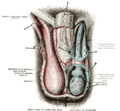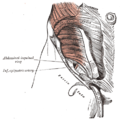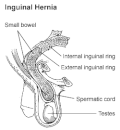Inguinal canal
Inguinal Canal
The Inguinal Canal is an important structure in the anatomy of the groin region of the human body. It is a passage in the anterior abdominal wall which in men conveys the spermatic cord and in women the round ligament of the uterus.
Anatomy[edit]
The Inguinal Canal is approximately 4 cm long and is directed inferomedially. It is superior and parallel to the medial half of the inguinal ligament. The canal commences at the deep inguinal ring, lateral to the inferior epigastric vessels, and ends at the superficial inguinal ring, superomedial to the pubic tubercle.
Boundaries[edit]
The Inguinal Canal has various boundaries which include:
- Anterior wall: Formed by the external oblique muscle and the internal oblique muscle.
- Posterior wall: Formed by the transversalis fascia laterally and the conjoint tendon medially.
- Roof: Formed by the arching fibers of the internal oblique muscle and the transversus abdominis muscle.
- Floor: Formed by the inguinal ligament and the lacunar ligament.
Contents[edit]
The contents of the Inguinal Canal differ between males and females. In males, it contains the spermatic cord, while in females, it contains the round ligament of the uterus.
Clinical Significance[edit]
The Inguinal Canal is clinically significant as it is a common site for the occurrence of inguinal hernias. These are protrusions of abdominal cavity contents through the inguinal canal. They are divided into two types: indirect inguinal hernia and direct inguinal hernia.
See Also[edit]
Ad. Transform your life with W8MD's Budget GLP-1 injections from $75


W8MD offers a medical weight loss program to lose weight in Philadelphia. Our physician-supervised medical weight loss provides:
- Weight loss injections in NYC (generic and brand names):
- Zepbound / Mounjaro, Wegovy / Ozempic, Saxenda
- Most insurances accepted or discounted self-pay rates. We will obtain insurance prior authorizations if needed.
- Generic GLP1 weight loss injections from $75 for the starting dose.
- Also offer prescription weight loss medications including Phentermine, Qsymia, Diethylpropion, Contrave etc.
NYC weight loss doctor appointmentsNYC weight loss doctor appointments
Start your NYC weight loss journey today at our NYC medical weight loss and Philadelphia medical weight loss clinics.
- Call 718-946-5500 to lose weight in NYC or for medical weight loss in Philadelphia 215-676-2334.
- Tags:NYC medical weight loss, Philadelphia lose weight Zepbound NYC, Budget GLP1 weight loss injections, Wegovy Philadelphia, Wegovy NYC, Philadelphia medical weight loss, Brookly weight loss and Wegovy NYC
|
WikiMD's Wellness Encyclopedia |
| Let Food Be Thy Medicine Medicine Thy Food - Hippocrates |
Medical Disclaimer: WikiMD is not a substitute for professional medical advice. The information on WikiMD is provided as an information resource only, may be incorrect, outdated or misleading, and is not to be used or relied on for any diagnostic or treatment purposes. Please consult your health care provider before making any healthcare decisions or for guidance about a specific medical condition. WikiMD expressly disclaims responsibility, and shall have no liability, for any damages, loss, injury, or liability whatsoever suffered as a result of your reliance on the information contained in this site. By visiting this site you agree to the foregoing terms and conditions, which may from time to time be changed or supplemented by WikiMD. If you do not agree to the foregoing terms and conditions, you should not enter or use this site. See full disclaimer.
Credits:Most images are courtesy of Wikimedia commons, and templates, categories Wikipedia, licensed under CC BY SA or similar.
Translate this page: - East Asian
中文,
日本,
한국어,
South Asian
हिन्दी,
தமிழ்,
తెలుగు,
Urdu,
ಕನ್ನಡ,
Southeast Asian
Indonesian,
Vietnamese,
Thai,
မြန်မာဘာသာ,
বাংলা
European
español,
Deutsch,
français,
Greek,
português do Brasil,
polski,
română,
русский,
Nederlands,
norsk,
svenska,
suomi,
Italian
Middle Eastern & African
عربى,
Turkish,
Persian,
Hebrew,
Afrikaans,
isiZulu,
Kiswahili,
Other
Bulgarian,
Hungarian,
Czech,
Swedish,
മലയാളം,
मराठी,
ਪੰਜਾਬੀ,
ગુજરાતી,
Portuguese,
Ukrainian












